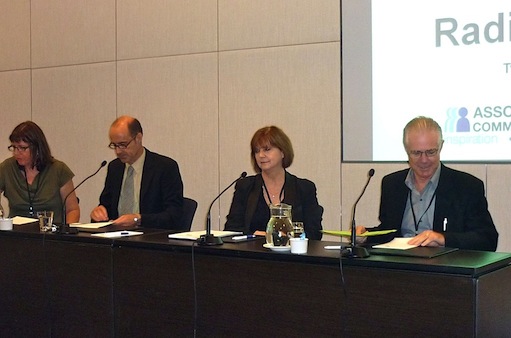Full powered capital city community radio stations will this year move onto the digital radio platform. At the Broadcasting Summit this week Kath Leitch revealed that RPH stations, 4EB, 4AAA and others have already launched on the new transmission technology and more are coming on each month. The community radio sector has a right to two ninths of the transmission multiplexes which it shares with commercial radio, but faces the problem of fitting in all of the stations into that proportion of the multiplex. Consultant David Sice explained that the community sector has adapted to this problem by giving each station a lower bit rate than the standard allocation of 128 kilobits.
On the same digital radio panel at the summit, CRA’s Joan Warner updated delegates on the progress of digital radio in Australia. Her key points included:
• 18 months on air at full power in five states
• 602,000 listeners to DAB+ in an average wk
• 212,000 plus digital radios in the market (not including Christmas retail sales)
• TSL to DAB+ is double that of Internet Radio
• Up to 18 new digital only stations in each market
• More than 70 different receivers on sale in 650 retail stores, plus online.
The ABC’s Russell Stendell confirmed the ABC’s commitment to the DAB+ platform, even in regional Australia, as the national broadcaster’s priority. He did not however, completely rule out consideration of DRM as a possible supplementary technology sometime in the future.
Stendell also revealed that some time this year ABC Radio will launch an Unearthed digital radio channel based on the popular triple j initiative.
As digital radio moves into 2011, community radio stations which can offer innovative new content will enhance the offering for the whole sector, enriching what is already on offer from commercial radio, the ABC and SBS Radio’s digital channels. Leith committed during the discussion that the community sector will “pull its weight” in trying to promote the new stations for the benefit of community stations and the whole industry.
Some of the continuing issues which are still to solve as digital radio matures in this market will include:
* getting factory fitted digital radios into cars (expected in the next few years),
* regional spectrum availability (ACMA confirmed it is working on is),
* what to do with low powered suburban community stations (no solution yet because there is * no more available spectrum in capital cities),
* digital radio receivers in phones (on the way but power drain issues are a continuing issue).


Community radio has been ripped off in the current digital plan - In Sydney each of the metro-wide stations will get a tiny 64kbps to broadcast. In Melbourne it will be worse (Only 56kbps each). Fairness and parity have been thrown out the window. And so much for "CD quality" sound.
I find AAC+ at 64K is fine. 56K or 64K will be good for the AM community stations in Melboutne such as 3KND and 3CR. Sure 128 or even higher would be great for all stations but even most commercial stations run at 64K with no real worries. 96FM in Perth is an exception running at 128K